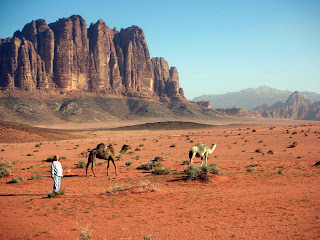The caption above each image is actually a snippet from the manuscript.
First let's get acquainted with the area the story revolves around, mostly in Judea and Samaria.
First let's get acquainted with the area the story revolves around, mostly in Judea and Samaria.
The land was under the control of the Hashemite kingdom (Jordan) till 1967. It was lost to Israel following the Six day war on June of that same year. Since then a almost a 100,000 Jewish settlers have made that area their home. It is feared that any attempt of relinquishing that land to the Palestinian people, may cause the Jewish settlers to rise and oppose violently such actions by the Israeli government.It is their belief that the land was given to them by God, thus government has no right to remove them.
The particular fortress he planned to survey on that day was called the Bastion of Dagon, located seven miles from Jericho on top of Jabel Al Qarantal. A cone-shaped hill with a Greek monastery, it was situated on its eastern side about two-thirds of the way up.
The air was stagnant. Standing at the edge of the hill looking east, Professor Robert Young thought he could see the peak of Mount Nebo far in the distance. The complete desolation and the exhausting heat turned his mood gloomy. Vale Achor, door of hope. He almost wanted to laugh. Why would anyone use the word 'hope' to describe this place? No trees, no bushes. Not one green patch. Just sand and rocks. The hope he would find the treasure was equally matched with doubt. The 8th century BC prophet Hosea, who uttered those words, must have been one incredibly optimistic guy.
Another view of Hyrkania (Khirbet Mird)
In his mind's eye, he could see his father. He remembered a day, many years ago, when the two of them stood at the foot of a hill. The Arabs called it Khirbet Mird. They got off their horses by the man-sized entrance carved into the rock. It was then that Elazar realized he was standing at the entrance to the tunnel his father had told him so much about. He was standing at the epicenter of Sicarii history. The place where the man from Masada had buried God's treasure. A short tremble moved through his body..
The Qumran cave Q3, where the Copper Scrolls were found in 1952
This is how the Copper Scrolls look like, currently housed in a museum in Amman, Jordan.
Here are some interesting facts about the Copper Scrolls,

“I know a place,” said Young. “It is south of here, in Wadi Rum, where the chief of the Hawyatat lives. It is the largest Bedouin tribe in Jordan and the northern parts of Saudi Arabia combined. About ten years ago I helped the chief’s son out of some trouble. The chief said that if I ever need his help all I had to do was ask.” (Author's note - The location where the movie "Lawrence of Arabia," directed by David Lean was made)
The Second Temple of Jerusalem had taken 10,000 masons eight years to renovate. Ten of the thirteen giant gates, adorned with gold and silver, studded the thick, high walls. Inside, 160 marble pillars, each 36 feet high, held up a roof of polished cedar trees. Both Jews and Gentiles could enter the Outer Court, but only the former were allowed into the inner court. It was from there that Elazar Ben Yair directed the carnage and plunder
At Khirbet Mird, Elazar and Menachem left four men to stand guard at the entrance to the tunnel and began descending stairs that had been carved into the stone two thousand years before. It quickly became difficult to breathe. At about 350 feet below ground they reached a small cavern. The beams of their flashlights illuminated a small mound in the center.
The Breastplate of Judgment was first mentioned in the Book of Exodus. Thirty-five hundred years ago, Aaron the brother of Moses carried it as a sign of his religious authority. Biblical accounts described it as being inlaid in cloth woven of five different threads and linen, the gems sewn onto it

More locations to come on the next post,







No comments:
Post a Comment